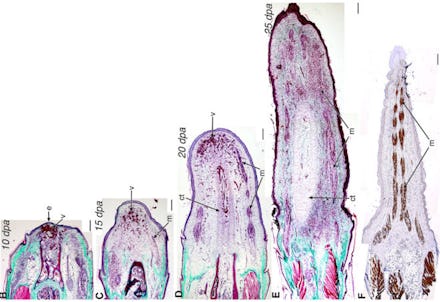Scientists Are Getting Closer to Growing Human Limbs

This is an image of a lizard regrowing a lost tail.
How that phenomenal process happens — a discovery that would have huge implications for regrowing lost limbs in humans — has been a mystery until this week, when scientists landed on the exact genes the critters use to regrow new appendages.
In other words, Spider-Man's limb-regenerating nemesis The Lizard may no longer be the stuff of sci-fi.
Here's how it works: Like humans, lizards have powerful on-switches in their genetic material that control specific bodily functions. As it turns out, about 300 of those genes are responsible for generating a new limb. According to new research from Arizona State University, similar chunks of human DNA could help scientists repair damaged spinal cords and even replace missing arms and legs.
Here's how (real) lizards do it: When a lizard loses its rear appendage, the wound starts healing and new blood vessels form along the lesion and the soft tissue seals the gash shut (like the kind under a fresh scab). After about two weeks, a new tail begins to form, starting with nerve tissue from the lizard's spinal cord. Eventually, soft new muscle begins to line the new limb and a tube of cartilage forms that will break into separate tail bones within two months' time.
Humans and lizards: The lizards the scientists studied, called green anoles, are our most closely related family members in the animal kingdom that can regrow entire appendages. Of the 326 lizard genes the researchers identified, mammals have 302 that are strikingly similar. Scientists think we could use these on-switches to capitalize on the lizard's limb-regenerating abilities and eventually regrow human tissue.
In the past, researchers thought the key to human limb regrowth lied in switching off a single gene that they suspected blocked our regenerative abilities as a protective measure. When scientists switched off that gene in mice, it opened up their cells' ability to transform into whatever type of tissue was needed. Turning off the special gene came with a price, though, too: Because its activity happened to be closely linked with another gene that controls cell division, switching it off can also result in cancer.
This is huge: The discovery would be a game-changer for the nearly 2 million Americans and more than 10 million people across the globe who have lost limbs as a result of vascular diseases or trauma. The technology could also be used to help regrow other tissues, from cartilage to spinal cord, potentially restoring function to the more than 300,000 people with spinal cord injuries in the United States.
Even if the discovery doesn't allow us to sprout new arms in comic book fashion, the new research has some other immediate benefits. For starters, it could help doctors learn to heal wounds more efficiently, something that could save millions on battlefields and in emergency rooms across the globe.